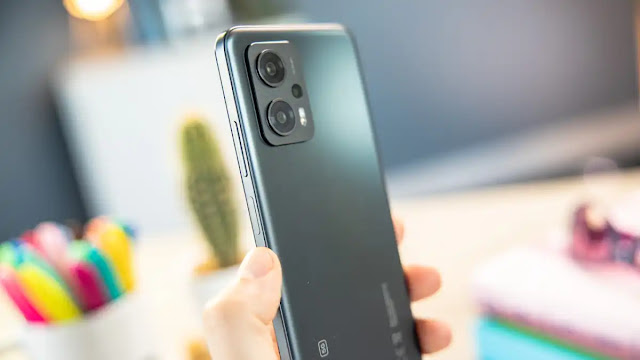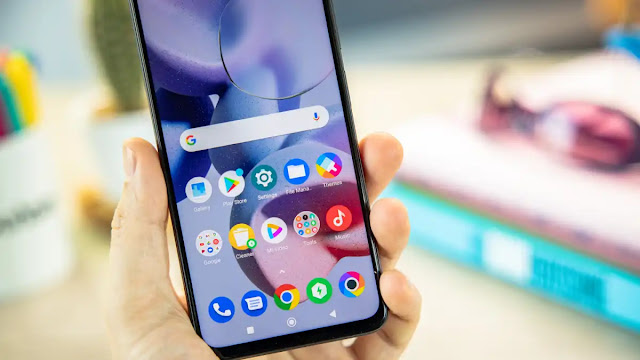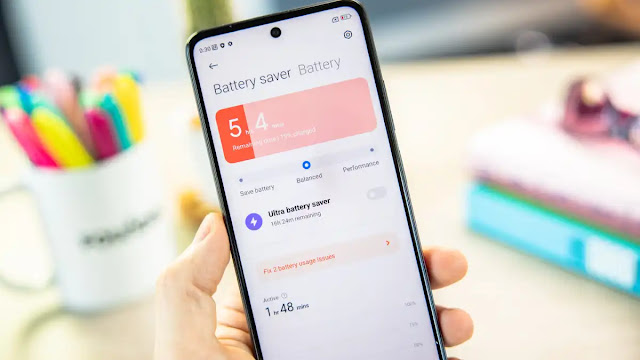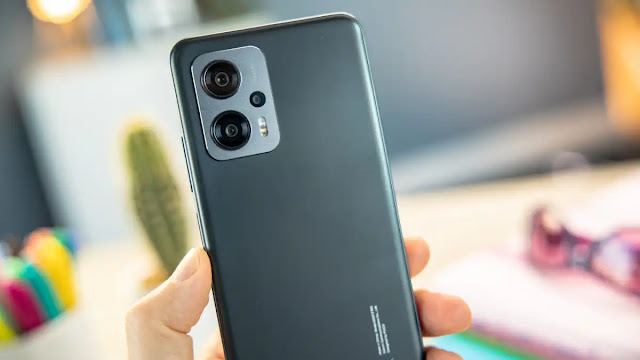Flagship performance for a budget price.
Pros
- Amazing performance for the price
- Very good IPS screen
- Fast charging (charger included)
Cons
- No water-resistance rating
- Rivals have OLED screens
- So-so secondary cameras
Our Verdict
We’ve become used to Xiaomi’s Poco-branded phones outdoing the completion for value and offering a near-flagship experience for surprisingly low prices.
The X4 GT, however, doesn’t quite live up to those expectations. But don’t write it off just yet: there’s a lot to like and you might well be happy to accept some of the compromises if you value the things that are truly great about this phone. And there are quite a few of those.
Features & Design
- Plastic frame and back
- Silver, blue and black models
- Headphone jack (with Hi-Res audio support)
Although the X4 GT is quite similar to last year’s X3 GT, there are plenty of differences, too. The plastic frame has much squarer edges, which makes it feel thicker even though it isn’t.
The rear panel is made from plastic, too, and has a matt finish that doesn’t attract fingerprints. It looks plain, but when the light catches it at the right angle, it shines.
You can choose between silver, blue and black colours, and that applies to the frame and back. I was sent the silver model to review, and it’s better described as grey or even graphite.
The power button doubles as a fingerprint scanner and, like before, didn’t reliably unlock the phone for me. Maybe it’s just my fingers, but it was annoying nonetheless.
At 164x74x9mm, it’s quite a big phone, but this is par for the course at the moment. It weighs 200g which is, again, nothing out of the ordinary.
It’s good that there’s a transparent case included in the box.
What’s missing is any water-resistance rating. The Poco X3 GT was IP53-rated, but there’s nothing at all for the X4 GT. This could be a cost-saving measure as getting that rating is expensive. Chances are, given things like the rubber gasket around the SIM tray, the X4 GT will survive exactly the same sort of accidental splashes as its predecessor.
Screen & Speakers
- 6.6in IPS, 144Hz
- 20.5:9, 2460×1080 resolution
- Gorilla Glass 5
Many mid-range phones now use OLED screens, but Xiaomi has stuck with IPS for the X4 GT. Fortunately, it’s a lot better than the X3 GT’s display with much better viewing angles and an even higher refresh rate at 144Hz.
I measured a maximum brightness of 475 nits by manually adjusting the slider, but outdoors, the screen is capable of 600nits. That’s almost half what an OLED screen can output. It’s not quite enough to make it easy to watch videos in sunny conditions or see the viewfinder when taking photos or videos, but it’s fine everywhere else.
In fact, there’s a second niggle: the X3 GT had Gorilla Glass Victus, but the X4 GT steps down to Gorilla Glass 5. There’s no factory-applied screen protector either, so it’s advisable to buy one to avoid any damage to the screen.
There are stereo speakers which are decent by smartphone standards. They support Dolby Atmos and although you won’t choose to listen to music on them over headphones, they’re great for gaming and watching most videos.
The only issue is that the right-hand one (the one on the bottom edge) is noticeably louder than the left (top) one, so there’s an annoying right-hand bias.
Specs & Performance
- Dimensity 8100 5G chipset
- 8GB LPDDR5+
- 128GB / 256GB storage (UFS 3.1)
If the Poco X3 GT had impressive performance, the X4 GT is on another level. The MediaTek Dimensity 8100 chipset, really, is the highlight of the X4 GT.
It’s out of place in a phone costing this little: Realme’s GT Neo 3 also uses it, but costs considerably more.
With a multicore score of 3629 in Geekbench 5 (a bit lower than the Neo 3’s 3882) it’s still way faster than other mid-range phones.
That’s an understatement: it’s flagship-level fast, matching the Samsung Galaxy S22 Ultra and beating some others.
This may be just a synthetic benchmark, but it shows just how much value the Poco X4 GT offers – if you care about speed, that is.
Gaming prowess is pretty good, too. In GFXBench, frame rates were very respectable even if they weren’t quite up to flagship standards.
In real-world use, though, games such as Asphalt 9 and Real Racing 3 ran very smoothly, though you may well find that the refresh rate doesn’t automatically increase in every game. In Pokemon GO, for example, I had to hunt around in the settings to change the refresh rate, and even then the Android Developer options for showing the refresh rate reported it was running at only 60Hz. Twitter, Instagram and other apps ran at 120Hz, as do the Android menus, but I never saw any app running faster than 120Hz.
Compared to the X3 GT, Xiaomi has made the vapour chamber 32% bigger for better cooling, and I never noticed any issues with the X4 GT getting hot after prolonged use.
However, there were times when the X4 GT would become laggy. Example include wen exiting apps back to the home screen: app shortcuts and widgets took a couple of seconds to load. Some apps took longer than expected to launch and on occasion menus would display a spinning icon before displaying their contents. Hopefully these are MIUI 13 issues as there’s clearly no lack of raw power, and there was no correlation between working the phone hard and these glitches happening. They seemed to happen at random.
In terms of other hardware, there’s an IR blaster, NFC (which supports Google Pay), Bluetooth 5.3 and Wi-Fi 6. And while 5G isn’t part of the model name, this is a 5G phone. The SIM tray will take two nano-SIMs, but note that there’s no expandable storage: you’re stuck with the 128GB or 256GB you get. It’s worth getting the higher-capacity model as it’s not hugely more expensive.
Battery Life & Charging
I thought it was business as usual in the battery and charging department: the Poco X4 GT has the same battery capacity and same 67W charging as the X3 GT.
However, using the 67W charger and USB cable included in the box, charging was much slower. The X4 GT managed a one-third charge from empty in 15 minutes, and two thirds (65%) in half an hour. The X3 GT charged to 90% in 30 minutes.
The remaining third takes almost another half-hour for the X4 GT, with a full charge achieved in about 55 minutes.
In terms of battery life, the X4 GT will last two days with light use, but there’s enough juice for one day of hard use.
Cameras
- 64Mp (16Mp) main camera
- 8Mp ultra wide camera
- 2Mp macro camera
- 16Mp selfie camera
On paper, it looks like the X4 GT has the same camera setup as its predecessor, but the main sensor has been upgraded with a slightly larger one. It still has the same 64Mp resolution, but as with so many high-megapixel phone cameras, it’s really a 16Mp device. That’s because it uses a technique called pixel-binning which takes an average of each four pixels.
By default, then, you’ll get 16Mp photos from the X4 GT and – when taken outdoors in good light – they’ll be perfectly good. There’s plenty of detail, colours aren’t oversaturated and dynamic range is decent. You can force it to shoot in 64Mp mode, but there’s not a lot of point: yes, there’s a bit more detail, but you lose out on dynamic range and images are noisier.
Although the autofocus does a good job of ensuring shots are reliably sharp, this camera doesn’t deal well with movement. Even in good light, moving subjects – kids, pets, sports – will almost always be blurry.
Talking of blur, the portrait mode is surprisingly good. Although it can be fooled by messy hair and blur some of it, the overall impression is very pleasing.
Switch to the ultra-wide camera and you’ll see similar results to so many mid-range phones. Although photos look fine when viewed small (i.e. on the phone’s screen), zooming in reveals a lack of sharpness at the edges. Overall, dynamic range isn’t as good as the main camera, but it’s perfectly usable when you need a wider field of view.
The 2Mp macro camera is the same here as on just about every other phone: it’s a novelty that’s hard to use. There’s no autofocus, so whether your photo in in focus or not, or whether the right part of the photo is in focus is more down to luck than anything else.
Finding the Macro mode is a challenge. It isn’t in the main modes carousel, nor is it under the More section. It’s hidden away in the hamburger menu at the top right.
The camera app offers a 2x option, but this is merely digital zoom. It’s best to avoid it completely as the resulting photos are severely lacking in detail. You’d be better off using the 1x mode and cropping them in Google Photos or your favourite editor.
The 16Mp selfie camera isn’t bad, though it’d be nice if shots were a little sharper. Once again, dynamic range isn’t wonderful which leaves selfies looking a little flat. Portrait selfies are quite good, though, with realistic blurring of the background and reasonably good detection of the subject so hair and hands aren’t accidentally blurred.
The Poco X4 GT defaults to 1080p30 for video and offers good (electronic) stabilisation. It’s a shame that’s not available at 4K30, so you have to trade detail for smoothness.
You can shoot video using the ultra-wide camera, but you’re limited to 1080p30. This means video looks a bit fuzzy and – as with photos – you end up with smaller dynamic range.
Software
- Android 12 with MIUI 13
Opinions about MIUI 13 are mixed at Tech Advisor. Some of us quite like it, while others really don’t.
Part of the problem – but perhaps mainly for phone reviewers constantly swapping phones and having to learn where all the settings are – is that Xiaomi has made so many changes to stock Android.
As my colleague Lewis observes in his review of the X4 Pro 5G, the Settings app is a bit all over the place and in a very different order to Google’s version of Android which it uses on the Pixel 6. The notification shade is completely different too.
There’s also a sidebar which you can populate with your choice of games and other apps and Second Space, which is effectively a second, separate phone where you can install a different set of apps, have a completely separate camera roll and sign into apps with different accounts to the ‘First Space’. Switching between the two requires authentication, and it’s a good way to have separate personal and work phones without needing two separate devices.
One annoyance is the built-in security app. It has a virus scanner powered by Avast which is all well and good, but will interrupt what you’re doing to scan newly installed apps rather than handling that in the background. And it also shows adverts while those scans take place.
Price & Availability
The Poco X4 GT isn’t sold officially in the UK or US. It’s aimed more at Europe whether the price for the 128GB model is €379 – €20 cheaper than the Poco F4. The 256GB version is €429.
However, while it isn’t sold by big-name retailers, you will find it for sale in the UK for a little under £300. If you want the official UK model, that’s the Poco X4 Pro 5G which (at the time of this review) was one of the top choices in our roundup of the best mid-range phones.
If you click Buy Now on Poco’s website, you’ll arrive at Aliexpress where all three colours are available for $299 / £259 / €303. Or, if you want the 256GB model, it’s $329 / £285 / €333.
Verdict
On paper, the Poco X4 GT looks amazing. It ticks virtually every box for a mid-range phone, yet comes in at the very bottom end in terms of price.
It has a flagship-level processor, 144Hz screen, big battery, fast charging, a good camera setup and dual-SIM 5G. You even get extras such as the headphone jack, stereo speakers and a 67W charger.
But the reality isn’t quite as impressive. Yes, the Dimensity 8100 is hugely quick and the screen is a big improvement over the X3 GT’s. However, the cameras – overall – aren’t the best, there’s no (official) water-resistance rating, the stereo speakers aren’t well balanced and MIUI13 does lag from time to time. Maybe this will be fixed with software updates, but it disappointed me in my time with the phone.
It therefore depends what you want from your phone. It could be a good option for anyone looking for an affordable gaming phone, but if you’d trade some performance for an OLED screen and better cameras, there are other options (including the aforementioned Poco X4 Pro 5G). Admittedly, most rivals cost more than the X4 GT, so if you’re on a strict budget and can live with the negative aspects, it’s very good value indeed.
Specs
- 6.6in LCD display (144Hz, FHD+)
- MediaTek Dimensity 8100
- 8GB RAM
- 128GB or 256GB storage
- Rear cameras:
- 64Mp f/1.9 main rear camera
- 8Mp f/2.2 ultra-wide camera
- 2Mp f/2.4 macro lens
- 20Mp f/2.5 selfie camera
- Fingerprint sensor in power button
- 3.5mm headphone jack
- 5G
- Bluetooth 5.3
- WiFi 6
- 5080mAh battery
- 67W fast charging
- 163.6 x 74.3 x 8.9 mm
- 200g
- Colours: Black, Silver, Blue









.jpg)
.jpg)
.jpg)
.jpg)
.jpg)
.jpg)
.jpg)
.jpg)
.jpg)
.jpg)
.jpg)
.jpg)
.jpg)


0 comments:
Post a Comment